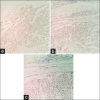Low-grade intraductal carcinoma in minor salivary glands: A case report and clinical insights
- PMID: 38800436
- PMCID: PMC11126239
- DOI: 10.4103/jomfp.jomfp_500_22
Low-grade intraductal carcinoma in minor salivary glands: A case report and clinical insights
Abstract
Rationale: Low-grade intraductal carcinoma (LG-IC), is a rare malignant tumour of the salivary glands which has a very good prognosis and must be differentiated from the other types of salivary gland malignant tumours, which have a totally different behaviour and a worse prognosis.
Patient concerns: A case is presented of a 52-year-old woman who was first diagnosed and treated in another clinic in 2019 for an LG-IC in the left submandibular gland space. Two years later, she was admitted to our department with a new lesion, this time in the upper jaw lip on the left side, which also turned out to be LG-IC.
Diagnosis: Magnetic resonance imaging and positron emission tomography-computed tomography were performed in order to diagnose and adequately stage the disease prior to the therapeutic intervention.
Outcomes: A 6-month follow-up reveals no sign of recurrence.
Takeaway lessons: Literature on this rare histopathological entity, as well as the differential diagnosis with the other malignant lesions of the salivary glands and the frequency of metastasis, were reviewed.
Keywords: Low-grade intraductal carcinoma; metastasis; minor salivary gland tumours; oral cancer; second primary cancer.
Copyright: © 2024 Journal of Oral and Maxillofacial Pathology.
Conflict of interest statement
There are no conflicts of interest.
Figures







References
-
- Nishijima T, Yamamoto H, Nakano T, Hatanaka Y, Taguchi K, Masuda M, et al. Low-grade intraductal carcinoma (low-grade cribriform cystadenocarcinoma) with tumor-associated lymphoid proliferation of parotid gland. Pathol Res Pract. 2017;213:706–9. - PubMed
-
- El-Naggar AK, Chan JCK, Grandis JR, Takata T, Slootweg PJ. In:WHO Classification of Tumours of the Oral Cavity. 4th ed. Lyon: IARC; 2017. WHO Classification of Head and Neck Tumours. Available from: https://apps.who.int/bookorders/anglais/detart1.jsp?codlan=1&codcol=70&c... .
-
- Palicelli A. Intraductal carcinomas of the salivary glands:Systematic review and classification of 93 published cases. APMIS. 2020;128:191–200. - PubMed
Publication types
LinkOut - more resources
Full Text Sources
